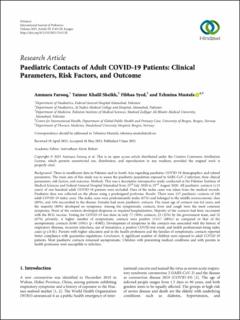| dc.contributor.author | Farooq, Ammara | |
| dc.contributor.author | Sheikh, Taimur Khalil | |
| dc.contributor.author | Syed, Fibhaa | |
| dc.contributor.author | Mustafa, Tehmina | |
| dc.date.accessioned | 2021-08-13T13:33:47Z | |
| dc.date.available | 2021-08-13T13:33:47Z | |
| dc.date.created | 2021-06-27T13:01:03Z | |
| dc.date.issued | 2021 | |
| dc.identifier.issn | 1687-9740 | |
| dc.identifier.uri | https://hdl.handle.net/11250/2767828 | |
| dc.description.abstract | Background. There is insufficient data in Pakistan and in South Asia regarding paediatric COVID-19 demographics and related parameters. The main aim of this study was to assess the paediatric population exposed to SARS-CoV-2 infection, their clinical parameters, risk factors, and outcome. Methods. This was a descriptive retrospective study conducted at the Pakistan Institute of Medical Sciences and Federal General Hospital Islamabad from 23rd July 2020 to 22nd August 2020. All paediatric contacts (≤13 years) of one hundred adult COVID-19 patients were included. Data of the index cases was taken from the medical records. Paediatric data was collected on the phone using a predesigned proforma. Results. There were 137 paediatric contacts of 100 adult COVID-19 index cases. The index cases were predominantly males (67%) and belonged to the middle socioeconomic class (89%), and 14% succumbed to the disease. Females had more paediatric contacts. The mean age of contacts was 6.6 years, and the majority (80%) developed no symptoms. Among the symptomatic contacts, fever and cough were the most common symptoms. None of the contacts developed dyspnoea or required hospitalization. Majority of the contacts had been vaccinated with the BCG vaccine. Testing for COVID-19 was done in only 77 (56%) contacts, 25 (32%) by the government team, and 52 (67%) privately. A higher number of symptomatic contacts were positive (15/17 (88%)) as compared to that of the asymptomatic contacts (6/60 (10%)) (p = 0:002). Development of symptoms in the contacts was associated with the history of respiratory illnesses, recurrent infections, use of hematinics, a positive COVID-test result, and health professionals being index cases (p ≤ 0:01). Parents with higher education and in the health profession and the families of symptomatic contacts reported better compliance with quarantine regulations. Conclusion. A significant number of children were exposed to adult COVID-19 patients. Most paediatric contacts remained asymptomatic. Children with preexisting medical conditions and with parents in health profession were susceptible to infection. | en_US |
| dc.language.iso | eng | en_US |
| dc.publisher | Hindawi | en_US |
| dc.rights | Navngivelse 4.0 Internasjonal | * |
| dc.rights.uri | http://creativecommons.org/licenses/by/4.0/deed.no | * |
| dc.title | Paediatric Contacts of Adult COVID-19 Patients: Clinical Parameters, Risk Factors, and Outcome | en_US |
| dc.type | Journal article | en_US |
| dc.type | Peer reviewed | en_US |
| dc.description.version | publishedVersion | en_US |
| dc.rights.holder | Copyright 2021 The Authors | en_US |
| dc.source.articlenumber | 2141128 | en_US |
| cristin.ispublished | true | |
| cristin.fulltext | original | |
| cristin.qualitycode | 1 | |
| dc.identifier.doi | 10.1155/2021/2141128 | |
| dc.identifier.cristin | 1918726 | |
| dc.source.journal | International Journal of Pediatrics | en_US |
| dc.identifier.citation | International Journal of Pediatrics. 2021, 2021, 2141128. | en_US |
| dc.source.volume | 2021 | en_US |

